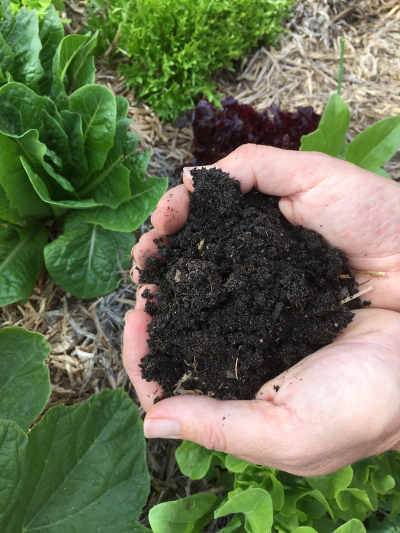Over the years I have noticed that the best gardeners I know are all passionate about their soil. Whether it is Peter Cundall looking lovingly at a handful of good soil muttering sweet nothings like “……..so good you could eat it”, or Lolo Houbein author of One Magic Square and Outside the Magic Square, or any number of other equally good but lesser known great gardeners. There was a direct correlation between their passion for their earth and their gardening prowess – it is no coincidence.
Years ago, I remember talking to a radio host about soil and she simply glazed over as she wasn’t interested. I was trying hard to grab her attention and suggested that soil has a bit of a perception problem – it’s not viewed as sexy or hip, like growing your own vegies, and it’s not showy or trendy, like flowers or indoor plants. Yet the truth is without good soil, we wouldn’t do well growing any of the above, so it is important that we get interested and excited about it. I suggested that maybe we needed a worm as a visual mascot, to remind people of the life within their soil and that they should treasure it and respect and care for their soil. She remained suitably unimpressed by my idea, and in the end suggested that we might do better getting some footballers mud wrestling!? However we do it, we must increase our appreciation and respect for soil. Soil grows plant life, and plant life supports us, so soil supports us.
One of the first things that we must all do to fall in love with our soil is to realize that our soil is brimming with life, whether we can see it or not as at least one quarter of the world’s biodiversity lives underground.
Alive and Well
 Worms
Worms
Earthworms are remarkable, living for up to 8 years and processing up to 30 tonnes of earth in their lifetime. One important job of these tireless workers is to help break down organic matter, and then mix it through the soil to improve its structure and texture. This helps improve water penetration and retention in the soil and helps improve soil aeration. Worms also increase the availability of nutrients in the soil, as well as help to increase the activity of the soil microbes. This improvement in soil health results in improved plant growth.
As well as the earthworms, it is the tiny, microscopic creatures that you can’t see with the naked eye which are equally, if not more important, although these same organisms are often misunderstood. In 1 teaspoon of healthy, organic enriched soil there are many units of life as there are people on the planet. These life forms include bacteria and mycorrhizal fungi, and much more. What do these tiny creatures do? Some of the beneficial bacteria in soil help to break down soil borne pathogens and pollutants, while others help to sequester atmospheric carbon dioxide, which in our current world state is very profound. Mycorrhizal fungi have many functions but one important one is that they extend the actual root system of our plants by a ‘surrogate’ root system known as hyphae, which give our plants far greater access to moisture and nutrients.
For those that are troubled by the sinister sound of the words bacteria and fungi be reassured that our world would not function without microbes, in fact without the five million-trillion-trillion microbes which live here. In fact, every human body contains trillions of microbes, with more than 10 times as many microbes living on and inside our bodies as we have human cells.
 Mycobacterium Vaccae
Mycobacterium Vaccae
One of the microbes in soil currently being studied further is Mycobacterium vaccae, a natural soil bacterium has been found to triggers the release of serotonin, helping to elevate mood and decrease anxiety. Many gardeners may have said or heard others say “I feel so good when I get my hands in the soil” – now you know why! This same bacterium has been found to improve cognitive function and the ability to learn new tasks and is currently being studied further as it may be able to help with the treatment of cancer patients.
Feed Your Soil
So, what can we do to make sure we have got lots of worms and microbes in our soil? The number one ingredient to add to soil to improve it is organic matter. This is basically anything that was once living and includes compost or aged animal manures. Sure, if you have heavy clay soil you are going to need to incorporate some gypsum, and conversely sandy, non-wetting soils might benefit from the addition of clay such as bentonite, but organic matter really is the key. As well as feeding the life in your soil, organic matter has a profound effect on your soil’s water holding capacity – it basically turns your soil into a sponge. Each 1% increase in soil organic matter increases the water holding capacity of your soil by up to 1.5 buckets of water per 1 square metre. That is significant!
It is also very important that you think about anything which you put on your soil – is it going to feed the soil life or kill it? Synthetic chemical-based fertilizers, insecticides, herbicides, fungicides, and soil additives such as soil-wetters, are harmful to the soil flora, while organic additives such as compost, animal manures, organic fertilizers and plant tonics encourage and feed the soil life. Mulching over the warmer weather is also important as it keeps the soil cool and lets these creatures live on, whereas worms and microbes will disappear from soil which is exposed and allowed to get hot, dry and bake.
Soil is ‘the lungs of the earth’ ………….so fall in love with your soil and you will have a great garden!
PS. I would encourage everyone interested in soil or gardening or the environment to read ‘Soil’ by Matthew Evans.
Read more at:
http://blog.nutri-tech.com.au/soil-as-medicine/





